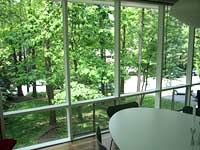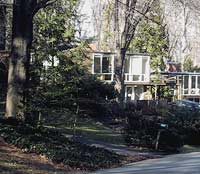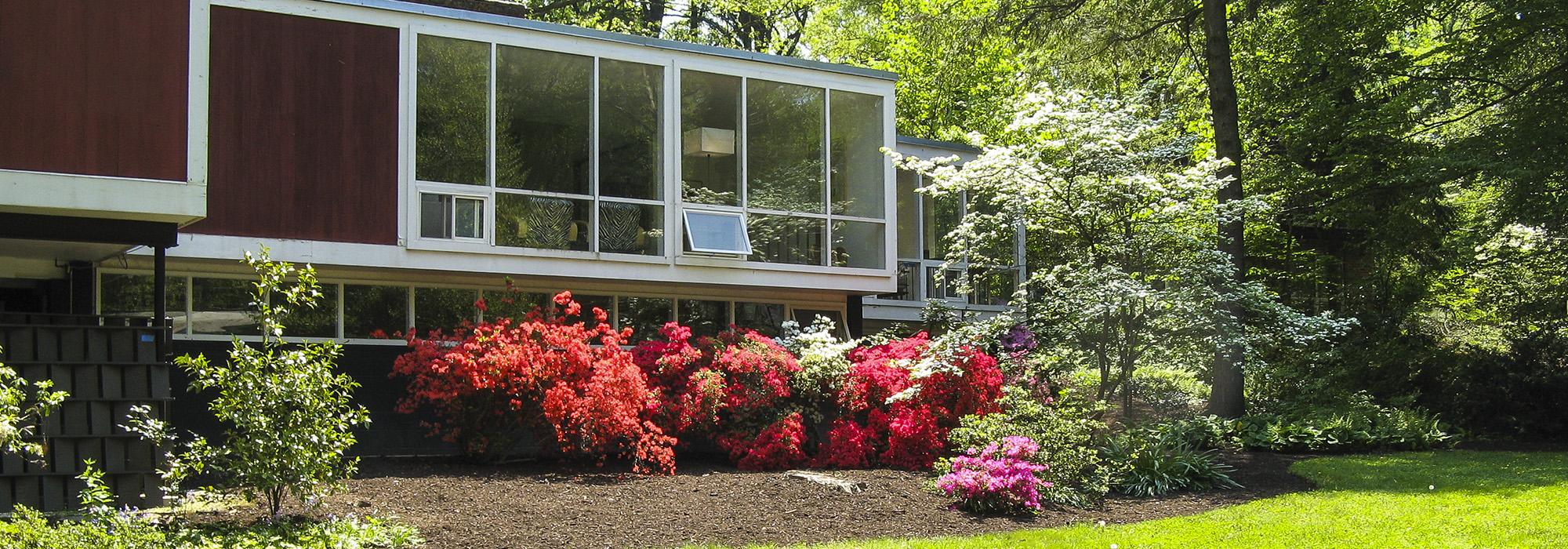Hollin Hills VA - Architecture and Landscape

Hollin Hills, located just south of Alexandria in Fairfax County, Virginia, is a community of approximately 450 homes built by developer Robert Davenport. A retreat in the midst of the Northern Virginia suburbs, the majority of the houses were designed by architect Charles Goodman, a key player in the development of the Modernist aesthetic in the Washington, DC metropolitan area. The noted landscape architect Dan Kiley designed as many as 100 landscape plans, most unrealized.
Why
During Hollin Hills' 50th anniversary in 1999, beyond the celebrations including house and garden tours, walks, a gala evening, and oral history, a major book was self-published by the community. "Hollin Hills: Community of Vision" reviews the neighborhood's development and history, with extensive illustrations. Talks are underway about whether to reprint this sold-out volume. However, even before the idea of documenting Hollin Hills in a publication, there was discussion about nominating the neighborhood as a district.
What kind of documentation
In 1996, the monthly community newsletter, the Hollin Hills Bulletin, laid out the options-a Fairfax County overlay district with attending local review process attached; the Virginia Landmarks Register; the National Register of Historic Places, a listing kept by the National Park Service, Department of Interior, of culturally important places in the United States; and National Historic Landmark (NHL) status, also a listing kept by the National Park Service.
Hollin Hills maintains its own Design Review Committee and process for approving changes to the architectural character of the neighborhood. Given this internal monitoring mechanism, the county overlay district with additional restrictions was never thought to be a viable process. Hollin Hills has been listed on the Fairfax County Inventory of Historic Sites since 1977. NHL status usually is awarded only in exceptional circumstances and often years after a district has been on the National Register. This left the two obvious methods of documentation as the logical possibilities-nomination to state and national registers.
Timing and Motivation
It proved too big a project to pursue a nomination project during or immediately after the rigors of the 50th anniversary's year of events. A new nudge to move forward with nomination came in spring 2003 when community members received an invitation to attend meetings sponsored by the Montgomery County Maryland National Capital Parks and Planning Commission.
The meetings centered around nominating Charles Goodman-designed neighborhoods in Montgomery County to the National Register and were organized by Joey Lampl. After attending several of their meetings, it was easier to consider thinking about the process of nominating Hollin Hills, Goodman's best-known community. Hollin Hills is now actively working to nominate the neighborhood as a historic district to the Virginia Landmarks Register and to the National Register of Historic Places.
With interim approval granted in 2005 from the Virginia Department of Historic Resources (VDHR), Virginia 's state historic preservation office, through their Preliminary Information Form process, the period of focus for Hollin Hills is 1949 to 1971. Given the neighborhood's largely consistent design philosophy, and with an enlightened attitude by the VDHR, the so-called "50-year-rule" for National Register nominations has been stretched to include the majority of the build-out period for Hollin Hills.


How
The first step in the project was to convince the board of the Civic Association of Hollin Hills that seeking nomination was a positive move. Board and community members were then informed and educated through ongoing articles in the Hollin Hills Bulletin, adding information and links to the Hollin Hills website, www.hollinhills.org, and arranging lectures and talks to further explain the process and long-term impacts of nominating a historic district to state and national registers. The National Register Nomination Committee was appointed by the Civic Association and the process began.
Practical Decisions
Evaluating how to prepare the nomination meant reviewing available volunteer time, knowledge, and experience within the community. Knowing that there was a large neighborhood of 450 houses to document, the decision was made to meld available community volunteer resources with the expertise of an outside historic preservation consultant.
With an initial timeline and budget of $35,000, the major costs of the project include hiring a consultant to prepare the application and guide the community through the nomination process. EHT Traceries, Inc. also is helping design the survey that will document the neighborhood. After training, volunteers from the community are expected to perform the survey.
Education and Fundraising
Education and fundraising go hand in hand. The community needed to know why the project cost so much and be apprised on a continuing basis of the project's status. Educational evenings included having Joey Lampl discuss Montgomery County 's Charles Goodman project in fall 2003 and David Edwards from VDHR review the state and National Register processes in spring 2004. Fundraising began in earnest during summer 2004 and has been achieved through special letters, the annual community dues renewal process, house and garden tours, a barbecue, and by asking a group of active community members to participate in a fundraising brainstorming session.
The process included having committee members attend every community meeting and event armed with knowledge, answers, information, and volunteer forms. It also included being on panels to spread the word about Hollin Hills at the Washington, DC, Design Within Reach store in spring 2005 and working with the local AAUW chapter to videotape and air a special program on the nomination process on the Fairfax County's cable TV station in 2005.
Benefits
Of critical importance in a nomination project of this size is to be as positive as possible about benefits-the importance of documenting a very special neighborhood-a relatively ephemeral idea for most people.
Educating homeowners on the benefits of being on state and national registers is critical. In Virginia, there is the possibility of financial benefits for Hollin Hills homeowners, particularly state tax credits for major home rehabilitation and repair projects for work approved by the VDHR. Although unlikely in the case of Hollin Hills, National Register status would prompt a special review process for any federally funded projects that might affect the historic district. Above all, continually reassuring Hollin Hills homeowners that there will not be greater restrictions placed on them has been a significant aspect of the educational process.
Beyond expanding the knowledge of Hollin Hills' architectural design and landscaped setting and community history within the neighborhood, around the Washington metropolitan area, and the county at large, encouraging preservation and recognition of other Modernist communities is a goal.
Where are we now in the process
Since surveys and the necessary attendant photography are generally accomplished in winter months when trees are bare-and Hollin Hills is full of trees!!-these projects are scheduled for early 2006.
Going into any multiple-year project is a challenge. Nominating Hollin Hills to state and national registers is proving just that. However, community members rallied initially to make the decision to seek nomination and are continuing their support of the project.
Future
Like many neighborhoods in the metropolitan area, the high price of housing has led to a quickened pace of development and redevelopment. Hollin Hills faces the same pressures and it will be an ongoing challenge to maintain the unique character of the community and Charles Goodman's legacy from the possible threat of teardowns and MacMansionization. The strength of community covenants, the Design Review Committee, and the Design Review Guidelines will become increasingly important in protecting the architecture and landscape of Hollin Hills. These things, along with Fairfax County regulatory processes and ongoing vigilance on the part of community members, are the best hope for retaining the ambiance of the neighborhood.
The goal of the nomination project is a district documented by late 2006/early 2007 and a plaque that says the neighborhood merits its status. However, the real value will have been the process itself and the new and renewed connections that have been formed and strengthened between neighbors. This is what keeps Hollin Hills a vital and committed community.





